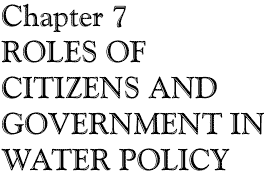
| ch. 7, pp. 86 - 89 |
ADWR has authority over some aspects of groundwater pumping within an area designated as the Tucson Active Management Area (TAMA). This includes most of the Pima County portion of the Santa Cruz River watershed. (See Preface, Figure 4, which is a map of TAMA.) ADWR performs overall groundwater supply planning for the area. The agency also approves or denies well drilling permits for all wells except small domestic wells and sets conservation requirements for water providers. ADWR cannot, however, regulate pumping to protect riparian areas nor can the agency coordinate the activities of various users or agencies with water responsibilities. (More information about ADWR’s powers and responsibilities is provided later in this chapter.)
The Arizona Department of Environmental Quality (ADEQ) and the U.S. Environ- mental Protection Agency (EPA), are concerned with the quality of groundwater and surface water. Their mandate is to prevent pollution of water supplies to ensure that consumers get safe drinking water. The Arizona Corporation Commission (ACC) regulates rates charged by private water companies, but not by irrigation districts or municipal utilities. Its role of protecting the water consumer sometimes conflicts with ADWR’s role of requiring water conservation or the use of renewable supplies instead of groundwater. For example, ADWR might require that a utility adopt water-saving strategies. To adopt such strategies, a water provider might need to raise water rates to cover the cost. The ACC, however, has rarely allowed the increased rates. ACC has even prevented rate increases to build treatment facilities to improve water quality. A rate increase is only allowed after a facility is actually in place. Tucsonans have experienced occasional water quality problems over the past 100 years. A flowing Santa Cruz River once was used as a water supply, and its quality at times was impaired by cattle and human waste. Shallow wells tended to produce alkali-tainted water. Outhouses contaminated the shallow water table. Tucson was not unique. Throughout the United States in the nineteenth century water-borne diseases such as cholera, diarrhea, dysentery or typhoid were prevalent. Measures were taken to control water quality problems and laws passed to require that water providers adopt such measures. For example, chlorine was found to be a highly effective disinfectant by the late 1800s, and most major municipal supplies were chlorinated by 1920. A dramatic drop in water-borne diseases in the United States resulted. By the 1950s, however, people began to be concerned about human-made pollutants, especially toxic substances such as DDT. Developing technologies to deal with chemical pollutants took longer than working out solutions to health problems relating to bacteria and viruses. The problem was more complex, with thousands of different pollutants. Recently, concern has focused on parasites found in water supplies, such as cryptosporidium and giardia. These have caused widespread sickness, even death in several cities and are difficult to control by traditional methods. Various legislative efforts were made to improve water quality. Congress passed the Clean Water Act in 1972 to protect surface waters from pollution. The law initially listed only a small number of pollutants, but more were added to the list as the law was applied over time. The act attempts to maintain water quality by controlling the kinds of wastes that are released to surface waters. In 1974, Congress passed the Safe Drinking Water Act to assure that drinking water supplies were safe. In 1980, Congress passed the Comprehensive Environmental Response, Compensation and Liability Act (CERCLA), more commonly known as the Superfund Act. This law is designed primarily to clean up areas that were polluted in the past and to prevent the occurrence of future contamination from hazardous materials. In 1980, the Arizona Legislature passed the Environmental Quality Act which, among other intents and purposes, protects the quality of groundwater. Other significant laws that protect water qu ality regulate hazardous materials and disposal of wastes. Most of these laws are discussed later in this chapter. Table 7-1 briefly shows which agencies are responsible for various water management matters. Surface Water Quality Federal and state laws and regulations, under the umbrella of the federal Clean Water Act, regulate surface water quality. The state and EPA administer portions of the federal program. States have the right to set their own water quality standards using EPA guidelines. These standards are to be reviewed every three years. EPA then issues permits and, if needed, takes enforcement actions based on the standards. EPA, however, also issues National Pollution Elimination Discharge System (NPDES) Permits. Point Sources Point sources of pollution are those sources that come from a discreet location such as a pipe. Point source discharge standards and permits are based on the adoption of the best available pollution reduction technology. Point sources are much easier to regulate than non-point sources — pollutants that come from a wide area, with no discreet discharge point. A local example of a point source is the outflow pipe from the Ina Road Water Pollution Control Facility. The law requires that the level of water quality necessary to protect existing designated uses be maintained and protected. No degradation of existing water quality is permitted in a navigable water if the existing water quality does not meet applicable water quality standards. Where existing water quality in a navigable water meets or exceeds applicable water quality standards, the existing water quality must be maintained and protected. A procedure exists, however, for the ADEQ director to allow limited degradation in some cases.
|

